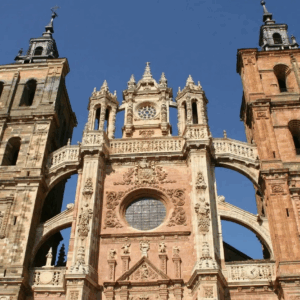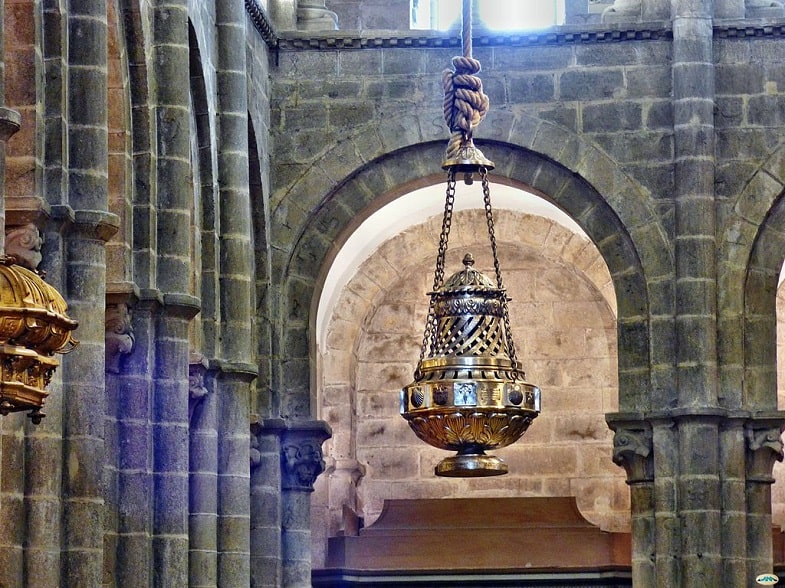The Secrets of the Cathedral of Santiago

Tabla de contenidos
4 Tips for shopping in Santiago
The Cathedral of Santiago de Compostela It is one of the most emblematic monuments in Spain and a key destination for millions of pilgrims from all over the world. Located in the capital of Galicia, this majestic church is the end point of the famous Camino de Santiago, a pilgrimage route that has been traveled by travelers for more than a thousand years.
However, beyond its impressive architecture and its deep religious importance, there are a series of curiosities and secrets of the Cathedral of Santiago. These secrets have captured the imagination of visitors and scholars alike. Below, we will explain some of the most fascinating mysteries of this iconic building.
Galicia Travels products
-

Rias Baixas Excursion
Rated 4.93 out of 530,00€ – 55,00€Price range: 30,00€ through 55,00€ Select date(s) This product has multiple variants. The options may be chosen on the product page -

French Way
360,00€ – 2.150,00€Price range: 360,00€ through 2.150,00€ Select options This product has multiple variants. The options may be chosen on the product page -
Sale!

Finisterre, Muxía, Costa da Morte
Rated 4.94 out of 520,00€ – 49,00€Price range: 20,00€ through 49,00€ Select date(s) This product has multiple variants. The options may be chosen on the product page -

Audioguide of the Cathedral of Santiago
Rated 5.00 out of 55,00€ Add to cart
1. The Holy Door and the Compostela Holy Year
One of the most intriguing elements of the cathedral is the Holy Door, also known as the Door of Forgiveness. This door, located at the back of the cathedral, in the Plaza de la Quintana, is only opened during the Compostela Holy Years, when July 25, the day of Saint James the Apostle, falls on a Sunday.
Crossing the Holy Door during the holy Year It is considered an act of great spiritual significance, as it is believed to grant plenary indulgence to those who do it with faith and devotion. This rite as old as the pilgrimage itself connects modern pilgrims with the traditions of the past, keeping alive a centuries-old practice that gives the cathedral an aura of mysticism and spirituality.
2. The Secrets of the Cathedral of Santiago: The Mystery of the Apostle Santiago
The cathedral houses, according to Christian tradition, the remains of the apostle James the Greater, a disciple of Christ. The story of how these remains arrived in Compostela is, in itself, an enigma. It is said that after the crucifixion of Jesus, Santiago traveled to Hispania to preach the word of God.
He returned to Palestine and was executed for his preaching work, at that time Christianity was illegal according to Roman laws, and after his death, his disciples took his body to Gallaecia on a stone boat, giving him burial in Santiago de Compostela, which at that time It was a small Roman town. It is for this reason that the place where the remains are found, the crypt of the cathedral, is a point of great reverence and mystery for visitors, being the nerve center of the Santiago cathedral.
Read also: How to prepare for the Camino de Santiago

3. The Botafumeiro and its Hidden Symbolisms
Another of the best kept secrets of the Cathedral of Santiago is the Botafumeiro, a huge silver censer that weighs more than 50 kg and measures 1.5 meters high. This unique object is used in the most important liturgical ceremonies and is famous for its swing at high speed along the cathedral transept.
Although it was originally used to purify the air and mask the smell of pilgrims who walked for many kilometers without any possibility of hygiene, the Botafumeiro It also has purer symbolism. It represents the connection between the sacred and the mundane, a bridge of smoke that ascends towards the firmament. Seeing it at the pilgrim mass is an impressive experience that does not leave any observer indifferent.
4. The Porch of Glory
The Porch of Glory, the work of Master Mateo, is another of the cathedral’s hidden treasures. This masterpiece of Romanesque sculpture is packed with details that have fascinated scholars for centuries. In its complex design, there are representations of the Apostles, Prophets, Angels, and various scenes of the Last Judgment.
However, some experts believe that the Portico contains hidden esoteric messages, related to alchemy and arcane knowledge. The figures carved into the portico, with their enigmatic expressions and postures, invite contemplation and personal interpretation, suggesting that there is more to this work than meets the eye. It is undoubtedly the great work of the European Romanesque, full of symbolism and mystery, where experts still do not agree on what all its symbols mean.
Read also: 5 things to do in Santiago
5. The Hidden Passages of the Cathedral
The cathedral of Santiago It is also known for its hidden passageways and secret crypts, which fuel numerous legends. It is said that these passageways were used by monks and clerics to move discreetly through the cathedral and its surroundings. Additionally, there are stories that speak of hidden treasures buried deep within the cathedral, especially during the time of the Viking invasions or Francis Drake’s attempts to attack the city in the 16th century.
On those occasions would be when the inhabitants would have hidden the treasures of the cathedral to protect them from looting, including the remains of the Apostle himself.
6. The secret of Jacobean shells
Finally, the scallop shells, symbol of the Camino de Santiago, are integrated into many aspects of the cathedral’s architecture. Beyond their role as a guide for pilgrims, some scholars have suggested that these shells also have a hidden meaning, related to ancient fertility and protection cults from pre-Christian times.
The symbolism of the shell is a reminder of the syncretism that has characterized the history of the cathedral and the city, where the pagan and the Christian often come together in mysterious ways.
Conclusion
The Cathedral of Santiago de Compostela is not only an architectural marvel and an important pilgrimage center, but also a place full of secrets and enigmas that invite exploration and reflection.
From its ancient history to its mystical legends and occult symbols, the cathedral continues to be a place of mystery and fascination, attracting those seeking not only a religious experience, but also a journey through time and spirituality. And in terms of trips and experiences, the city of Santiago can contribute a lot.
Agencies such as Galicia Travels located in the city of Apostol offer travelers who want to explore the mysteries of the city numerous
